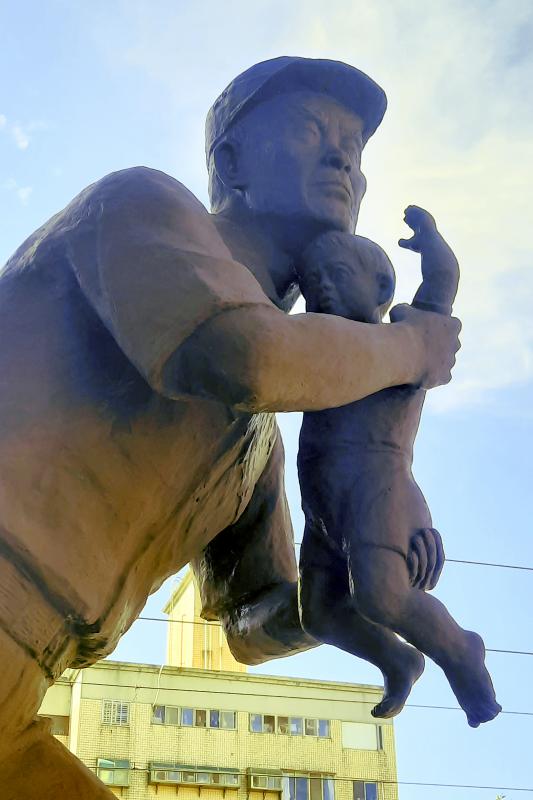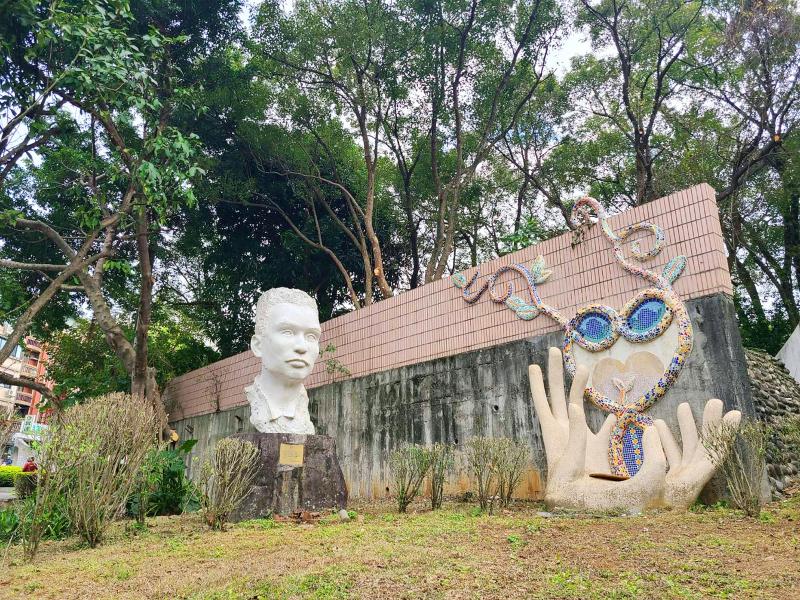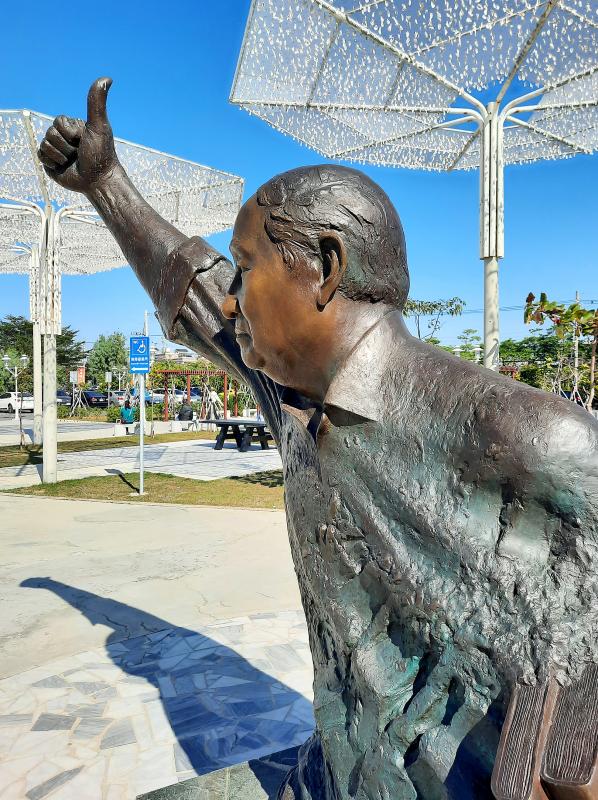Taiwanese are used to seeing statues, even if most of those of long-gone dictator Chiang Kai-shek (蔣介石) have been relocated to the Chiang Kai-shek Cihu Statue Park (慈湖蔣公銅像公園) in Taoyuan’s Dasi District (大溪). In addition to political leaders, statues of less well known individuals, honored for doing something remarkable, are dotted around the country.
TANG GAO: BENEVOLENT BABY SNATCHER
It’s a memorable line in a mediocre 1990s movie. In Tin Cup, the character played by Kevin Costner says: “When a defining moment comes along, you define the moment... or the moment defines you.”

Photo: Steven Crook
On the afternoon of Jan. 4, 1976, sergeant Tang Gao (唐高) defined the moment.
Born Tang Li-fa (唐立法) in China’s Jiangsu Province, Tang Gao — he’d used his brother’s name ever since enlisting in the Chinese nationalist army — was on duty near the main north-south railroad in Hsinchu City, as two children started to cross the tracks.
When the older child saw a southbound express bearing down on them, he panicked, leaving his 15-month-old companion, a boy surnamed Lin (林), in harm’s way.

Photo courtesy of Cheng Yu-en
Tang noticed and didn’t hesitate. He dashed over, scooped up Lin, and threw him to safety on a patch of grass. But rescuing the youngster cost Tang his life. He was hit by the train, and died in hospital.
Like many of the soldiers who’d followed Chiang Kai-shek to Taiwan in 1949, Tang was unmarried and childless. According to traditional folk belief, this is an unspeakably awful circumstance in which to die. Without descendants who can carry out the proper rites and provide sacrifices of incense and joss paper, a deceased person is condemned to an eternity of beggar-like misery in the afterworld.
It was hardly a surprise, then, that Lin’s parents consented to a posthumous adoption which made Tang, for the sake of ancestor-worshiping duties, the boy’s father. Such arrangements weren’t uncommon back when Taiwan was a highly traditional society. In most cases, however, they connected individuals who were already related. For example, a man might assign one of his sons to his own brother, if the sibling had died before begetting an heir.

Photo: Steven Crook
Very soon after Tang’s death, the authorities decided that the sergeant’s selfless act deserved a permanent memorial. Funds were raised, and Chiayi-born Pu Hao-ming (蒲浩明) was commissioned to create a bronze statue of Tang rescuing the little boy. Pu’s maternal grandfather was none other than Chen Cheng-po (陳澄波), the renowned painter who was murdered outside Chiayi Railway Station during the 228 Incident of 1947.
The statue, which was unveiled on Sept. 1, 1977, is on Jhonghua Road (中華路) Section 4, just east of the intersection with Dingpu Road (頂埔路) in Hsinchu’s Siangshan District (香山).
PHILANTHROPIST SHI QIAN
Born in 1899, Shi Qian (施乾) grew up in an era when poverty was commonplace, but that didn’t stop him from doing his utmost to alleviate it.
After completing a technical course, Shi was employed by a branch of the Japanese colonial government then ruling Taiwan, and assigned to investigate the living conditions of beggars in the Wanhua (萬華) area of Taipei. (It’d be interesting to know if the colonial authorities were motivated by a genuine desire to improve the lives of those unfortunates, or if their main concern was that urban poverty could lead to civil unrest.)
Once he’d got to know several of the individuals who begged outside Wanhua’s famous Longshan Temple (龍山寺), he began helping them. At first, he simply used his own time and money to ensure they ate properly and were able to stay clean.
Later, in 1923, he established Ai Ai Liao (愛愛寮), a homeless shelter. With the full support of his first wife — it’s said she sold her dowry to support her husband’s charitable endeavors — Shi bought land to expand the facility. Residents were expected to work toward self-sufficiency by raising chickens and pigs, growing vegetables, weaving hats and cobbling shoes.
According to a 1944 report, Ai Ai Liao was caring for 244 people, including 17 Japanese and 16 Chinese. Recorded reasons for admission included poverty, sickness, blindness, muteness, opium addiction and mental illness.
Shi was widowed in 1932, and the following year he married a woman from a wealthy Japanese family. Thanks to her devotion to Ai Ai Liao and her willingness to naturalize as a Republic of China citizen in 1945, the charity survived Shi’s sudden death in 1944 and the turmoil that followed World War II.
Now known as Ai Ai Hospital (愛愛院, aiai.org.tw), the foundation now operates care centers in Wanhua and Nangang (南港) districts.
A statue of Shi — who’s been called “Taiwan’s Mother Teresa” and “Taiwan’s Albert Schweitzer” — can be found in a small park at the intersection of Jhongshan and Wenhua roads (中山路文化路口) in Shi’s native Tamsui District (淡水), about 750m from Tamsui Station on the Taipei Metro’s Red Line.
INDEPENDENCE CAMPAIGNER HUANG ZHAO-TANG
In Tainan’s Cigu District (七股), the Huang Zhao-tang Memorial Park (黃昭堂紀念公園) celebrates the life and work of a local man who spent decades working for Taiwan’s independence from his base in Japan.
Huang was born in Longshan (龍山), a community that depended on fishing and aquaculture, in 1932. After studying Economics at National Taiwan University, he moved to Japan, where he obtained graduate degrees in International Relations and Sociology.
In 1964, he and other Taiwanese expatriates in Japan formed a pro-independence group that later became part of World United Formosans for Independence (WUFI). On its Web site (www.wufi.org.tw), WUFI describes its mission as “the establishment of a free, democratic and independent Republic of Taiwan in accordance with the principle of self-determination of peoples.”
In 1976, the University of Tokyo published a book about Taiwan’s unresolved status that Huang had cowritten with Peng Ming-min (彭明敏), a notable former dissident who died earlier this year.
Because of his outspoken opposition to Chiang Kai-shek and his regime, Huang couldn’t visit his hometown for decades. Not until 1992, after 34 years in exile, was it safe for him to return. Following his retirement from academia in 1998, he moved back for good. During the presidency of Chen Shui-bian (陳水扁), he served as a national policy advisor. He died in Taipei on Nov. 17, 2011.
The bronze statue of Huang in the memorial park shows him carrying books and giving the thumbs up, as if concluding an impromptu speech between lectures.
The park is on the south side of Road 176, roughly equidistant between the popular attraction known as Cigu Salt Mountain (七股鹽山) and Taiwan Provincial Highway 17. Buses that stop nearby include the #99 Tainan Tourist Shuttle and the Blue #20.
Steven Crook has been writing about travel, culture and business in Taiwan since 1996. He is the author of Taiwan: The Bradt Travel Guide and co-author of A Culinary History of Taipei: Beyond Pork and Ponlai.

April 14 to April 20 In March 1947, Sising Katadrepan urged the government to drop the “high mountain people” (高山族) designation for Indigenous Taiwanese and refer to them as “Taiwan people” (台灣族). He considered the term derogatory, arguing that it made them sound like animals. The Taiwan Provincial Government agreed to stop using the term, stating that Indigenous Taiwanese suffered all sorts of discrimination and oppression under the Japanese and were forced to live in the mountains as outsiders to society. Now, under the new regime, they would be seen as equals, thus they should be henceforth

Last week, the the National Immigration Agency (NIA) told the legislature that more than 10,000 naturalized Taiwanese citizens from the People’s Republic of China (PRC) risked having their citizenship revoked if they failed to provide proof that they had renounced their Chinese household registration within the next three months. Renunciation is required under the Act Governing Relations Between the People of the Taiwan Area and the Mainland Area (臺灣地區與大陸地區人民關係條例), as amended in 2004, though it was only a legal requirement after 2000. Prior to that, it had been only an administrative requirement since the Nationality Act (國籍法) was established in

With over 80 works on display, this is Louise Bourgeois’ first solo show in Taiwan. Visitors are invited to traverse her world of love and hate, vengeance and acceptance, trauma and reconciliation. Dominating the entrance, the nine-foot-tall Crouching Spider (2003) greets visitors. The creature looms behind the glass facade, symbolic protector and gatekeeper to the intimate journey ahead. Bourgeois, best known for her giant spider sculptures, is one of the most influential artist of the twentieth century. Blending vulnerability and defiance through themes of sexuality, trauma and identity, her work reshaped the landscape of contemporary art with fearless honesty. “People are influenced by

The remains of this Japanese-era trail designed to protect the camphor industry make for a scenic day-hike, a fascinating overnight hike or a challenging multi-day adventure Maolin District (茂林) in Kaohsiung is well known for beautiful roadside scenery, waterfalls, the annual butterfly migration and indigenous culture. A lesser known but worthwhile destination here lies along the very top of the valley: the Liugui Security Path (六龜警備道). This relic of the Japanese era once isolated the Maolin valley from the outside world but now serves to draw tourists in. The path originally ran for about 50km, but not all of this trail is still easily walkable. The nicest section for a simple day hike is the heavily trafficked southern section above Maolin and Wanshan (萬山) villages. Remains of